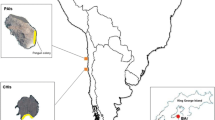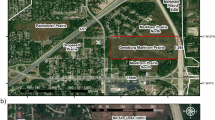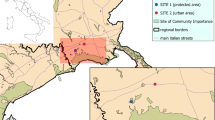Abstract
Penguins can bioaccumulate metals, a portion of which can be deposited in the environment through organic remains such as excrement, carcasses, and eggshells. In order to determine Cu and Pb concentrations and their relationship to soil, organic matter and grain size were determined in 27 samples collected in zones without penguins, penguin transit zones, and Adelie (Pygoscelis adeliae), Chinstrap (P. antarctica), and Gentoo penguin (P. papua) colonies on the Ardley Peninsula, Maritime Antarctica. An atomic absorption spectrophotometry analysis was carried out, organic matter was determined by loss on ignition, and grain size was measured with a laser diffraction particle size analyzer. The principal component analysis shows a relationship between the variables Cu, Pb, and grain size and areas with penguin presence. Cu concentrations in soils varied among areas (χ2, 15.707; p = 0.0004), with higher concentrations in transit zones and penguin colonies (142.63 and 140.79 mg/kg, respectively) than in zones without penguins (83.33 mg/kg). Pb concentrations in soils also varied among areas (χ2, 6.5029; p = 0.0387), and were higher in transit zones (5.92 mg/kg) than in the penguin colonies (4.45 mg/kg). Grain size differed significantly among areas (χ2, 13.506; p = 0.0012), with higher values in transit zones (avg. 37.38 μm) than in penguin colonies (avg. 26.93 μm) and zones without penguins (avg. 20.72 μm). Organic matter did not differ significantly among the studied zones (χ2, 2.0882; p = 0.3520). There is a positive correlation between Cu-Pb (Rho, 0.5532; p = 0.0028), Cu-grain size (Rho, 0.4756; p = 0.0130) and Pb-grain size (Rho, 0.4879; p = 0.0098). The presence of penguins increases Cu concentrations in Antarctic soils due to its bioaccumulation and elimination through excrement; however, the presence of penguins has a minor influence on Pb concentration in soil, probably because this metal is stored efficiently in bones, feathers, and eggshells.


Similar content being viewed by others
References
Abakumov, E., Lupachev, A., & Andreev, M. (2017). Trace element content in soils of the King George and Elephant islands, maritime Antarctica. Chemistry and Ecology, 33(9), 856–868.
Agency for Toxic Substances and Disease Registry (ATSDR). (2007). Public health statement lead. 13 pp.
Amaro, E., Padeiro, A., de Ferro, A. M., Mota, A. M., Leppe, M., Verkulich, S., & Canário, J. (2015). Assessing trace element contamination in Fildes peninsula (king George Island) and Ardley Island, Antarctic. Marine Pollution Bulletin, 97(1–2), 523–527.
Ancora, S., Volpi, V., Olmastroni, S., Focardi, S., Leonzio, C. (2002). Assumption and elimination of trace elements in Adélie penguins from Antarctica: a preliminary study. Marine Environmental Research, 54: 341–344, https://doi.org/10.1016/S0141-1136(02)00198-8.
Bargagli, R. (2008). Environmental contamination in Antarctic ecosystems. Science of the Total Environment, 400, 212–226. https://doi.org/10.1016/j.scitotenv.2008.06.062.
Berguño, J. (2009). Evolución y perspectivas del Sistema Antártico. Revista De Historia Internacional, 39, 70–84.
Bernal, M. P., Clemente, R., & Walker, D. J. (2007). The role of organic amendments in the bioremediation of heavy metal-polluted soils. In R. W. Gore (Ed.), Environmental research at the leading edge (pp. 1–57). New York: Nova Science Publishers Inc..
Besnard, E., Chenu, C., & Robert, M. (2001). Influence of organic amendments on copper distribution among particle-size and density fractions in champagne vineyard soils. Environmental Pollution, 112, 329–337. https://doi.org/10.1016/S0269-7491(00)00151-2.
Blais, J. M., Macdonald, R. W., Mackay, D., Webster, E., Harvey, C., & Smol, J. P. (2007). Biologically mediated transport of contaminants to aquatic systems. Environmental Science & Technology, 41(4), 1075–1084. https://doi.org/10.1021/es061314a.
Blott, J. (2010). Gradistat version 8.0: a grain size distribution and statistics package for the analysis of unconsolidated sediments by sieving or laser granulometer. Kenneth Pye Associates Ltd., Berkshire.
Bradl, H. B. (2004). Adsorption of heavy metal ions on soils and soils constituents. Journal of Colloid and Interface Science, 277, 1–18. https://doi.org/10.1016/j.jcis.2004.04.005.
Buduba, C. (2004). Muestreo de suelos. Criterios básicos. Patagonia Forestal, 10(1), 9–12.
Cañizares-Villanueva, R. (2000). Biosorción de metales pesados mediante el uso de biomasa microbiana. Revista de Microbiologia, 42, 131–143.
Carrasco, M. A., & Préndez, M. (1991). Elemental distribution of some soils of continental Chile and the Antarctic peninsula: projection to atmospheric pollution. Water, Air, and Soil Pollution, 57, 713.
Celis, J., Jara, S., González-Acuña, D., Barra, R., & Espejo, W. (2012). A preliminary study of trace metals and porphyrins in excreta of Gentoo penguins (Pygoscelis papua) at two locations of the Antarctic Peninsula. Archivos de medicina veterinaria, 44, 311–316. https://doi.org/10.4067/S0301-732X2012000300016.
Celis, J., Barra, R., Espejo, W., González-Acuña, D., & Jara, S. (2015). Trace element concentrations in biotic matrices of Gentoo penguins (Pygoscelis papua) and coastal soils from different locations of the Antarctic peninsula. Water, Air, & Soil Pollution, 226, 2266.
Dalfior, B. M., Roriz, L. D., Júnior, R. F., de Freitas, A. C., da Silva, H. E., Carneiro, M. T. W. D., Licinio, M. V. V. J., & Brandão, G. P. (2016). Avaliaçao dos teores de Pb, Cd, Sn, Co, Hg, Mo e As em solos da Península Fildes - Antártica. Química Nova, 39(8), 893–900.
Deheyn, D. D., Gendreau, P., Baldwin, R. J., & Latz, M. I. (2005). Evidence for enhanced bioavailability of trace elements in the marine ecosystem of Deception Island, a volcano in Antarctica. Marine Environmental Research, 60(1), 1–33. https://doi.org/10.1016/j.marenvres.2004.08.001.
Espejo, W., Celis, J. E., Sandoval, M., González-Acuña, D., Barra, R., & Capulín, J. (2017). The impact of penguins on the content of trace elements and nutrients in coastal soils of North Western Chile and the Antarctic peninsula area. Water, Air, & Soil Pollution, 228(3), 116.
Forcada, J. (2007). El cambio climático y sus repercusiones para la megafauna antártica. Duarte, C. In: Fundación BBVA (ed.). Impactos del calentamiento global sobre los ecosistemas polares. Bilbao, pp 83–108, https://doi.org/10.1111/j.1748-5827.2007.00325.x.
Flores-Vélez, L. M., Ducaroir, J., Jaunet, A. M., & Robert, M. (1996). Study of the distribution of copper in an acid sandy vineyard soil by three different methods. European Journal of Soil Science, 47, 523–532. https://doi.org/10.1111/j.1365-2389.1996.tb01852.x.
Ford, J., Landers, D., Kugler, D., Lasorsa, B., Allen-Gil, S., Crecelius, E., & Martinson, J. (1995). Inorganic contaminants in Arctic Alaskan ecosystems: long-range atmospheric transport or local point sources? Science of the Total Environment, 160(161), 323–335.
Gulson, B. L., Tiller, K. G., Mizon, K. J., & Merry, R. H. (1981). Use of lead isotopes in soils to identify the source of lead contamination near Adelaide. South Australia. Environmental Science & Technology, 15, 691–696. https://doi.org/10.1021/es00088a008.
Guo, X., Zhang, S., Shan, X., Luo, L., Pei, Z., Zhu, Y., Liu, T., Xie, Y., & Gaults, A. (2006). Characterization of Pb, Cu and Cd adsorption on particulate organic matter in soil. Environmental Toxicology and Chemistry, 25, 9.
Heiri, O., Lotter, A., & Lemcke, G. (2001). Loss on ignition as a method for estimating organic and carbonate content in sediments: reproducibility and comparability of results. Journal of Paleolimnology, 25, 101–110. https://doi.org/10.1023/A:1008119611481.
Jerez, S., Motas, M., Palacios, M. J., Valera, F., Cuervo, J. J., & Barbosa, A. (2011). Concentration of trace elements in feathers of three Antarctic penguins: geographical and interspecific differences. Environmental Pollution, 159, 2412–2419. https://doi.org/10.1016/j.envpol.2011.06.036.
Jerez, S. (2012). Los pingüinos: bioindicadores de la contaminación ambiental en la península Antártica e islas asociadas. Dissertation, University of Murcia, https://doi.org/10.4067/S0716-10182012000400018.
Jerez, S., Motas, M., Benzal, J., Diaz, J., & Barbosa, A. (2013a). Monitoring trace elements in Antarctic penguin chicks from South Shetland Islands, Antarctica. Marine Pollution Bulletin, 69, 67–75.
Jerez, S., Motas, M., Benzal, J., Diaz, J., Vidal, V., D’Amico, V., & Barbosa, A. (2013b). Distribution of metals and trace elements in adult and juvenile penguins from the Antarctic peninsula area. Environmental Science and Pollution Research, 20, 3300–3311.
Kraus, S., Kurbatov, A., & Yates, M. (2013). Geochemical signatures of tephras from quaternary Antarctic peninsula volcanoes. Andean Geology, 40(1), 1–40.
Liguang, S., Renbin, Z., Xuebin, Y., Xiaodong, L., Zhouqing, X., & Yuhong, W. (2004). A geochemical method for the reconstruction of the occupation history of a penguin colony in the maritime Antarctic. Polar Biology, 27(11), 670–678. https://doi.org/10.1007/s00300-004-0635-z.
Lozada-Zarate, E., Monks, S., Pulido-Flores, G., Gordillo-Martínez, A., Prieto-García, F. (2006). Determinación de metales pesados en Cyprinus carpio en la laguna de Metztitlán, Hidalgo, México. IV foro de investigadores por la conservación y II simposio de áreas naturales protegidas del estado de Hidalgo el 16 y 17 de octubre de 2006 en Pachuca, Hidalgo, México.
Lu, Z., Cai, M., Wang, J., Yang, H., & He, J. (2012). Baseline values for metals in soils on Fildes peninsula, King George Island, Antarctica: the extent of anthropogenic pollution. Environmental Monitoring and Assessment, 184, 7013–7021. https://doi.org/10.1007/s10661-011-2476-x.
Martorell, J. (2009). Intoxicaciones en aves. Hospital clínico de pequeños animales, 29(3), 172–178.
Mason, B. (1992). Preparation of soil sampling protocols: sampling techniques and strategies. Environmental Protection Agency, Washington, pp 169.
Mendonça, T., Melo, V., Alleoni, L., Schaefer, C., & Michel, R. (2013). Lead adsorption in the clay fraction of two soil profiles from Fildes peninsula. King George Island. Antarctic Science, 25(3), 389–396.
Metcheva, R., & Yurukova, L. (2011). Biogenic and toxic elements in feathers, eggs, and excreta of Gentoo penguin (Pygoscelis papua ellsworthii) in the Antarctic. Environmental Monitoring and Assessment, 182, 571–585. https://doi.org/10.1007/s10661-011-1898-9.
Michelutti, N., Blais, J. M., Mallory, M. L., Brash, J., Thienpont, J., Kimpe, L. E., Douglas, M. S. V., & Smol, J. (2010). Trophic position influences the efficacy of seabirds as metal biovectors. Proceedings of the National Academy of Sciences of the United States of America, 107, 10543–10548. https://doi.org/10.1073/pnas.1001333107.
Moskovchenko, D. V., Kurchatova, A. N., Fefilov, N. N., & Yurtaev, A. A. (2017). Concentrations of trace elements and iron in the Arctic soils of Belyi Island (the Kara Sea, Russia): patterns of variation across landscapes. Environmental Monitoring and Assessment, 189, 210.
Myrcha, A., & Tatur, A. (1991). Ecological role of the current and abandoned penguin rookeries in the land environment of the maritime Antarctic. Polish Polar Research, 12(1), 3–24.
Nie, Y., Liu, X., Sun, L., & Emslie, S. (2012). Effect of penguin and seal excrement on mercury distribution in sediments from the Ross Sea region. East Antarctica. Science of the Total Environment, 433, 132–140. https://doi.org/10.1016/j.scitotenv.2012.06.022.
Nygard, T., Lie, E., Rov, N., & Steinnes, E. (2001). Metal dynamics in an Antarctic food chain. Marine Pollution Bulletin, 42(7), 598–602. https://doi.org/10.1016/S0025-326X(00)00206-X.
Otero, X.L. & Mouriño, J. (2002). Nitrógeno (NH4+, NO3-), fósforo asimilable y metales traza (Hg, Cd, Pb, Zn, Ni y Cu) en suelos de la colonia de la gaviota patiamarilla (Larus cachinnans) en el parque natural de las islas Cíes. “Actas de la I reunión sistemas agroforestales – I reunión espacios naturales”, en Cuadernos de la sociedad española de ciencias forestales, 14: 143–149.
Padeiro, A., Amaro, E., Correia Dos Santos, M. M., Araújo, M. F., Gomes, S. S., Leppe, M., Verkulich, S., Hughes, K. A., Peter, H., & Canário, J. (2016). Trace element contamination and availability in Fildes peninsula, King George Island, Antarctica. Environmental Science: Processes & Impacts, 15, 18(6), 648–657.
Pereira, J. L., Pereira, P., Padeiro, A., Gonçalves, F., Amaro, E., Leppe, M., Verkulich, S., Hughes, K. A., Peter, H., & Canário, J. (2017). Environmental hazard assessment of contaminated soils in Antarctica: using a structured tier 1 approach to inform decision-making. Science of the Total Environment, 574, 443–454. https://doi.org/10.1016/j.scitotenv.2016.09.091.
Perfetti-Bolaño, A., & Moreno, L. (2013). Lead in colonies of pygoscelid penguins in Ardley Peninsula, Antarctica. In M. Leppe et al. (Eds.), Avances en Ciencia Antártica (pp. 505–508). La Serena: Instituto Antártico Chileno.
Peter, H.-U., Buesser, C., Mustafa, O., Pfeiffer, S. (2008). Risk assessment for the Fildes Peninsula and Ardley Island, and development of management plans for their designation as Specially Protected or Specially Managed Areas. Federal Environment Agency, Jena.
Planchon, F. A. M., Boutron, C. F., Barbante, C., Cozzi, G., Gaspari, V., Wolff, E. W., Ferrari, C. P., & Cescon, P. (2002). Changes in heavy metals in Antarctic snow from Coats Land since the mid-19th to the late 20th century. Earth and Planetary Science Letters, 200, 207–222. https://doi.org/10.1016/S0012-821X(02)00612-X.
Polito, M. J., Trivelpiece, W. Z., Patterson, W. P., Karnovsky, N. J., Reiss, C. S., & Emslie, S. D. (2015). Contrasting specialist and generalist patterns facilitate foraging niche partitioning in sympatric populations of Pygoscelis penguins. MEPS, 519, 221–237.
Qian, J., Shan, X., Wang, Z., & Tu, Q. (1996). Distribution and plant availability of heavy metals in different particle-size fractions of soil. Science of the Total Environment, 87, 131–141.
Ramos, L., Hernandez, L. M., & Gonzalez, M. J. (1994). Sequential fractionation of copper, lead, cadmium and zinc in soils from or near Doñana National Park. Joenq, 23, 50–57.
Royal Commission on Environmental Pollution (RCEP). (1983). Lead in the environment. RCEP ninth report. Southwood, T. R. E. (chairman). HMSO. London, pp 184.
Santamans, A. C., Boluda, R., Picazo, A., Gil, C., Ramos-Miras, J., Tejedo, P., Pertierra, L. R., Benayas, J., & Camacho, A. (2017). Soil features in rookeries of Antarctic penguins reveal sea to land biotransport of chemical pollutants. PLoS One, 12(8), e0181901. https://doi.org/10.1371/journal.pone.0181901.
Schulten, H. R., Leinweber, P., & Sorge, C. (1993). Composition of organic matter in particle-size fractions of an agricultural soil. European Journal of Soil Science, 44(4), 677–691. https://doi.org/10.1111/j.1365-2389.1993.tb02332.x.
Scokart, P. O., Meeus-Verdinne, K., & De Borger, R. (1983). Mobility of heavy metals in polluted soils near zinc smelters. Water, Air, and Soil Pollution, 20, 451–463. https://doi.org/10.1007/BF00208519.
Secretariat of the Antarctic Treaty. (2009). Final report of the thirtieth Antarctic treaty consultative meeting. Antarctic specially protected area no 150 (Ardley Island, Maxwell Bay, King George Island): revised Management Plan, pp 705.
Secretariat of the Antarctic Treaty. (2018). Northeast beach of Ardley Island. Review [2018 10, july]. https://www.ats.aq/devAS/ats_other_template.aspx?lang=e&id=7b118862-1b68-4ee9-9ad2-56f2f2e454b7.
Sheppard, D. S., Claridge, G. G. C., & Campbell, I. B. (2000). Metal contamination of soils at Scott Base. Antarctica. Applied Geochemistry, 15, 513–530. https://doi.org/10.1016/S0883-2927(99)00055-4.
Shi, G., Teng, J., Ma, H., Wang, D., & Li, Y. (2018). Metals in topsoil in Larsemann Hills, an ice-free area in East Antarctica: lithological and anthropogenic inputs. Catena, 160, 41–49. https://doi.org/10.1016/j.catena.2017.09.001.
Sims, D. B., Hudson, A. C., Keller, J. E., Konstantinos, V. I., & Konstantinos, M. P. (2015). Trace element scavenging in dry wash surficial sediments in an arid region of southern Nevada. USA. Mine Water and the Environment, 36(1), 124–132.
Simas, F. N. B., Schaefer, C. E. G. R., Melo, V. F., Guerra, M. B. B., Saunders, M., & Gilkes, R. (2006). Clay-sized minerals in permafrost affected soils (Cryosols) from King George Island, Antarctica. Clay Clay Min, 54, 721–736. https://doi.org/10.1346/CCMN.2006.0540607.
Smichowski, P., Vodopivez, C., Muñoz-Olivas, R., & Gutiérrez, A. (2006). Monitoring trace elements in selected organs of Antarctic penguin (Pygoscelis adeliae) by plasma-based techniques. Microchemical Journal, 82(1), 1–7. https://doi.org/10.1016/j.microc.2005.04.001.
Sterckeman, T., Douay, F., Proix, N., & Fourrier, H. (2000). Vertical distribution of Cd, Pb and Zn in soils near smelters in the north of France. Environmental Pollution, 107, 377–389. https://doi.org/10.1016/S0269-7491(99)00165-7.
Stevenson, F. J., & Welch, L. F. (1979). Migration of applied lead in a field soil. Environmental Science & Technology, 13, 1255–1259. https://doi.org/10.1021/es60158a005.
Stone, M., & Droppo, I. G. (1996). Distribution of lead, copper and zinc in sie-fractionated river bed sediment in two agricultural catchments of southern Ontario. Canada. Environmental Pollution, 93(3), 353–362. https://doi.org/10.1016/S0269-7491(96)00038-3.
Sun, L., & Xie, Z. (2001a). Changes in lead concentration in antarctic penguin droppings during the past 3. 000 years. Environmental Geology, 40, 1205–1208.
Sun, L., & Xie, Z. (2001b). Relics: penguin population programs. Science Progress, 84(1), 000–000.
United States Environmental Protection Agency. (1992). Acid digestion of sediments, sludges, and soils method 3050. Washington, United States, https://doi.org/10.17226/2022.
US EPA Estimation programs interface suite™ for Microsoft® Windows, v[4.1]. 2018; United States Environmental Protection Agency, Washington DC, USA. Available from: http://www.epa.gov/opptintr/exposure/pubs/episuite.htm [cited 2018 10. april], https://doi.org/10.3310/hsdr06370.
Wilson, R. P. (2010). Resource partitioning and niche hyper-volume overlap in free-living pygoscelid penguins. Functional Ecology, 24(3), 646–657. https://doi.org/10.1111/j.1365-2435.2009.01654.x.
Yan, X., Hu, Y., Chang, Y., Li, Y., Liu, M., Zhong, J., Zhang, D., & Wu, W. (2017). Effects of land reclamation on distribution of soil properties and heavy metal concentrations, and the associated environmental pollution assessment. Polish Journal of Environmental Studies, 26(4), 1809–1823. https://doi.org/10.15244/pjoes/68533.
Yarlagadda, P. S., Matsumoto, M. R., Van Benschoten, J. E., & Kathuria, A. (1995). Characteristics of heavy metals in contaminated soils. Journal of Environmental Engineering, 121, 276–286. https://doi.org/10.1061/(ASCE)0733-9372(1995)121:4(276).
Yin, X., Liu, X., Sun, L., Zhu, R., Xie, Z., & Wang, Y. (2006). A 1500-year record of lead, copper, arsenic, cadmium, zinc level in Antarctic seal hairs and sediments. Science of the Total Environment, 371, 252–257. https://doi.org/10.1016/j.scitotenv.2006.07.022.
Yin, X., Xia, L., Sun, L., Luo, H., & Wang, Y. (2008). Animal excrement: a potential biomonitor of heavy metal contamination in the marine environment. Science of the Total Environment, 399, 179–185. https://doi.org/10.1016/j.scitotenv.2008.03.005.
Yu, M. (2005). Environmental toxicology: biological and health effects of pollutants. Florida, United States.
Zreda-Gostynska, G., Kyle, P. R., Finnegan, D., & Meeker, K. (1997). Volcanic gas emissions from Mount Erebus and their impact on the antarctic environment. Journal of Geophysical Research, 102, 15039–15055. https://doi.org/10.1029/97JB00155.
Zwolicki, A., Barcikowski, M., Barcikowski, A., Cymerski, M., Stempniewicz, L., & Convey, P. (2015). Seabird colony effects on soil properties and vegetation zonation patterns on King George Island. Maritime Antarctic. Polar Biology, 38(10), 1645–1655. https://doi.org/10.1007/s00300-015-1730-z.
Acknowledgements
The authors would like to thank Instituto Antártico Chileno (INACH) and Correos de Chile for their support in carrying out this project (PR_01-12) during ECA 49. R. Barra and R. Urrutia are grateful for the support of CRHIAM (CONICYT/FONDAP 15130015).
Author information
Authors and Affiliations
Corresponding author
Additional information
Publisher’s Note
Springer Nature remains neutral with regard to jurisdictional claims in published maps and institutional affiliations.
Rights and permissions
About this article
Cite this article
Perfetti-Bolaño, A., Moreno, L., Urrutia, R. et al. Influence of Pygoscelis Penguin Colonies on Cu and Pb Concentrations in Soils on the Ardley Peninsula, Maritime Antarctica. Water Air Soil Pollut 229, 390 (2018). https://doi.org/10.1007/s11270-018-4042-4
Received:
Accepted:
Published:
DOI: https://doi.org/10.1007/s11270-018-4042-4




